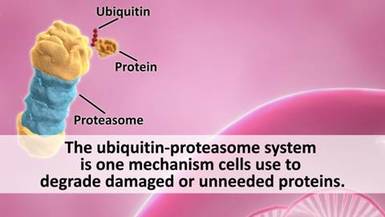ALS (Lou Gehrig's Disease) 2011 Breakthrough Discoveries

Ubiquitin-Proteosome Malfunction Relates to ALS. Credit: NCI NIH
Recently, Northwestern University Feinberg School of Medicine scientists reported in Nature (August 21, 2011) a common, unifying cause of ALS based on improper processing of damaged nerve proteins. This discovery may help toward an eventual ALS disease cure.
ALS Disease Signs, Symptoms and 2011 Data
Diseases are abnormal and harmful events or disorders that occur in living organisms. ALS, amyotrophic lateral sclerosis, is a very serious human disease that involves nerve degeneration, paralysis and eventually leads to death.
The ALS Foundation estimates that about 350,000 children and adult patients have ALS worldwide with about 50% of patients dying within three years of its onset. In the United States the National Institute of Neurological Disorders and Stroke estimates about as many as 30,000 people suffer from the disease. ALS causes progressive loss of muscle strength, paralysis and inability to move, speak, swallow and breathe. The ALS/dementia form of the disease targets the frontal and temporal lobes of the brain, affecting patients’ judgment, ability to understand language and to perform basic tasks like planning what to wear or organizing their day.
Brain and Spinal Cord Proteins – Nerve Protein Processing and Reprocessing is Important
Brain and spinal cord nerves normally quickly and properly recycle or process certain proteins by means of a special protein called “ubiquilin2”. In ALS, the protein recycling and processing system is broken and the nerve cells in the spinal cord and in brain’s cortex and hippocampus do not repair or maintain themselves and these nerve cells eventually die. The diseased nerve cells contain twisted threads of abnormal proteins. These aberrant proteins block, damage and destroy the nerve cells and eventually those nerve die.
Teepu Siddique, M.D., the senior researcher at Northwestern University has studied ALS for about 25 years and discovered the first ALS gene site and developed a genetic animal study for ALS. These new research findings on protein folding and recycling in ALS permit that drugs can be tested to correct or improve the protein processing pathways. New drugs may be found that may stabilize or normalize protein processing and permit removal of the damaged or misfolded proteins that occur in all three forms of ALS: hereditary (genetic), brain ALS/dementia and non-hereditary (sporadic) ALS. A newly-discovered genetic mutation has been found that is related to the first two forms of ALS which links hereditary and brain ALS/dementia as diseases with a common genetic cause.
All the Written Material within Site is Copyrighted 2011 and Owned by Dr. Donald Reinhardt, and this original material is protected legally by this copyright notice and by the Digital Millennium Act. None of this original material may be copied or reproduced without the expressed written consent of the author.
The author is a Freelance Science writer, and is available for specific assignments for those who are interested – by contacting adminstrator@sciencesuperchool.com. Other questions related to this teaching site should be directed to teacher@sciencesuperschool.com.
ALS Disease Signs, Symptoms and 2011 Data
Diseases are abnormal and harmful events or disorders that occur in living organisms. ALS, amyotrophic lateral sclerosis, is a very serious human disease that involves nerve degeneration, paralysis and eventually leads to death.
The ALS Foundation estimates that about 350,000 children and adult patients have ALS worldwide with about 50% of patients dying within three years of its onset. In the United States the National Institute of Neurological Disorders and Stroke estimates about as many as 30,000 people suffer from the disease. ALS causes progressive loss of muscle strength, paralysis and inability to move, speak, swallow and breathe. The ALS/dementia form of the disease targets the frontal and temporal lobes of the brain, affecting patients’ judgment, ability to understand language and to perform basic tasks like planning what to wear or organizing their day.
Brain and Spinal Cord Proteins – Nerve Protein Processing and Reprocessing is Important
Brain and spinal cord nerves normally quickly and properly recycle or process certain proteins by means of a special protein called “ubiquilin2”. In ALS, the protein recycling and processing system is broken and the nerve cells in the spinal cord and in brain’s cortex and hippocampus do not repair or maintain themselves and these nerve cells eventually die. The diseased nerve cells contain twisted threads of abnormal proteins. These aberrant proteins block, damage and destroy the nerve cells and eventually those nerve die.
Teepu Siddique, M.D., the senior researcher at Northwestern University has studied ALS for about 25 years and discovered the first ALS gene site and developed a genetic animal study for ALS. These new research findings on protein folding and recycling in ALS permit that drugs can be tested to correct or improve the protein processing pathways. New drugs may be found that may stabilize or normalize protein processing and permit removal of the damaged or misfolded proteins that occur in all three forms of ALS: hereditary (genetic), brain ALS/dementia and non-hereditary (sporadic) ALS. A newly-discovered genetic mutation has been found that is related to the first two forms of ALS which links hereditary and brain ALS/dementia as diseases with a common genetic cause.
All the Written Material within Site is Copyrighted 2011 and Owned by Dr. Donald Reinhardt, and this original material is protected legally by this copyright notice and by the Digital Millennium Act. None of this original material may be copied or reproduced without the expressed written consent of the author.
The author is a Freelance Science writer, and is available for specific assignments for those who are interested – by contacting adminstrator@sciencesuperchool.com. Other questions related to this teaching site should be directed to teacher@sciencesuperschool.com.